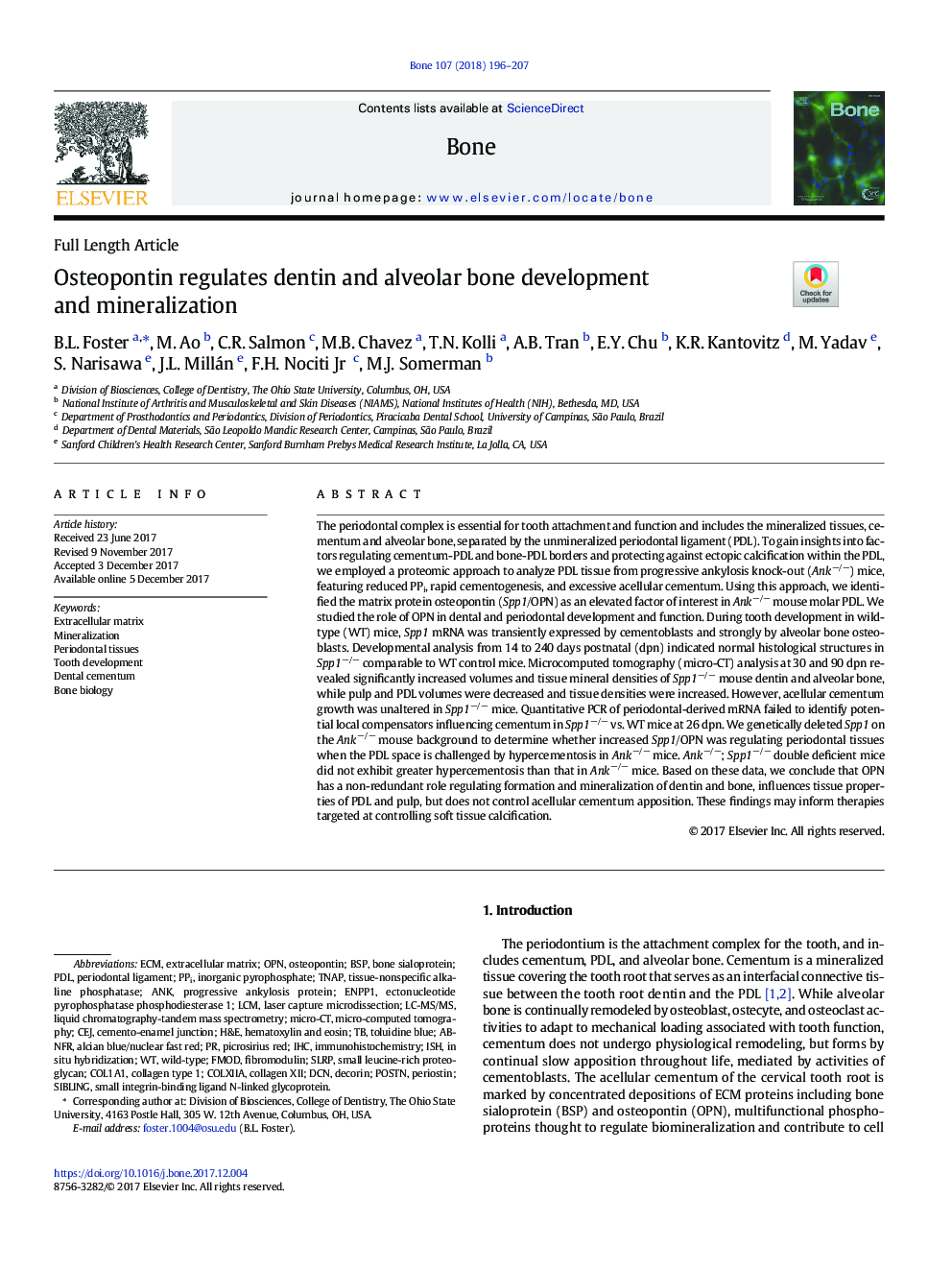| Article ID | Journal | Published Year | Pages | File Type |
|---|---|---|---|---|
| 8625216 | Bone | 2018 | 12 Pages |
Abstract
The periodontal complex is essential for tooth attachment and function and includes the mineralized tissues, cementum and alveolar bone, separated by the unmineralized periodontal ligament (PDL). To gain insights into factors regulating cementum-PDL and bone-PDL borders and protecting against ectopic calcification within the PDL, we employed a proteomic approach to analyze PDL tissue from progressive ankylosis knock-out (Ankâ/â) mice, featuring reduced PPi, rapid cementogenesis, and excessive acellular cementum. Using this approach, we identified the matrix protein osteopontin (Spp1/OPN) as an elevated factor of interest in Ankâ/â mouse molar PDL. We studied the role of OPN in dental and periodontal development and function. During tooth development in wild-type (WT) mice, Spp1 mRNA was transiently expressed by cementoblasts and strongly by alveolar bone osteoblasts. Developmental analysis from 14 to 240Â days postnatal (dpn) indicated normal histological structures in Spp1â/â comparable to WT control mice. Microcomputed tomography (micro-CT) analysis at 30 and 90Â dpn revealed significantly increased volumes and tissue mineral densities of Spp1â/â mouse dentin and alveolar bone, while pulp and PDL volumes were decreased and tissue densities were increased. However, acellular cementum growth was unaltered in Spp1â/â mice. Quantitative PCR of periodontal-derived mRNA failed to identify potential local compensators influencing cementum in Spp1â/â vs. WT mice at 26Â dpn. We genetically deleted Spp1 on the Ankâ/â mouse background to determine whether increased Spp1/OPN was regulating periodontal tissues when the PDL space is challenged by hypercementosis in Ankâ/â mice. Ankâ/â; Spp1â/â double deficient mice did not exhibit greater hypercementosis than that in Ankâ/â mice. Based on these data, we conclude that OPN has a non-redundant role regulating formation and mineralization of dentin and bone, influences tissue properties of PDL and pulp, but does not control acellular cementum apposition. These findings may inform therapies targeted at controlling soft tissue calcification.
Keywords
LCMCOL1A1PDLSLRPENPP1OPNECMANKBSPISHTNAPPPIEctonucleotide pyrophosphatase phosphodiesterase 1Collagen XIISmall Integrin-Binding LIgand N-linked GlycoproteinDCNfmodH&EIn situ hybridizationLC-MS/MSpicrosirius redTissue-nonspecific alkaline phosphataseOsteopontinIHCImmunohistochemistryCEJTooth developmentToluidine blueMicro-computed tomographySiblingdecorinPeriodontal ligamentBone biologybone sialoproteindental cementumLiquid chromatography-tandem mass spectrometryFibromodulinlaser capture microdissectionExtracellular matrixMineralizationMicro-CTwild-typeCollagen type 1Hematoxylin and Eosinsmall leucine-rich proteoglycanPeriostinPostninorganic pyrophosphate
Related Topics
Life Sciences
Biochemistry, Genetics and Molecular Biology
Developmental Biology
Authors
B.L. Foster, M. Ao, C.R. Salmon, M.B. Chavez, T.N. Kolli, A.B. Tran, E.Y. Chu, K.R. Kantovitz, M. Yadav, S. Narisawa, J.L. Millán, F.H. Jr, M.J. Somerman,
